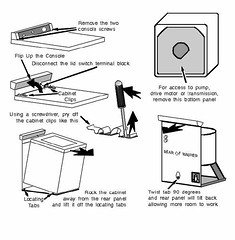AFFECTED MODELS:
Whirlpool: DU1050XTP, DU1100XTP, DU1101XTP, DU1145XTP, DU1148XTP, DUC600XTP, DUL240XTP, GU2400XTP, GU2500XTP, GU2548XTP, GU2600XTP, GU3200XTP;
KitchenAid: KUD x 01-6 (where “x” is any letter);
Kenmore: Whirlpool-built models.
All serial codes.
NUTSHELL:
Whirlpool has issued a service bulletin on this problem. Seems the heater fault-detection circuit is buggy. The condition can also apply to a dishwasher that has had the electronic control replaced.
The cause of the problem is an insufficient rise in water temperature during a pre-set time period. The heater fault-detection program that was added to the electronic control is designed to shut down the dishwasher if the board-test for proper water temperature rise is not sufficient.
GORY DETAILS:
The dishwasher run cycle was modified to add 8 minutes 45 seconds of heat at the beginning of the main wash cycle. If the inlet water at the thermistor is below 110°F, the thermistor looks for a water rise of 4°F. If the inlet water is over 110°F, the test is for an increase of 2°F. If the temperature rise is below specifications, the unit will drain and the clean light will blink seven times.
The detection described above is ignored if the temperature is out of the normal temperature range of 64°F to 160°F during this heat period. This thermistor temperature test is not done to increase water temperature for better washability, but to only assure that the heater is functioning.
Proper incoming water temperatures should be between 120°F to 140°F.
CORRECTIVE ACTION:
You will need to identify possible causes of insufficient temperature rise. These causes may include checking the wiring to/failure of the control, the heating element, the thermistor, the inlet valve, door switch, motor or capacitor. Make sure that water is not siphoning during fill. Once the heater fault detection is triggered and the condition resolved, the electronic control must be reset by initiating a special diagnostic cycle. Use the Product Tech Sheet shipped with each dishwasher — you’ll find it behind the kickplates — to identify the correct cycle sequence. The rapid advance cycle will not properly reset the electronic control.
 A doubleheader! Just uploaded two more episodes of our award-winning appliance repair podcast.
A doubleheader! Just uploaded two more episodes of our award-winning appliance repair podcast.




